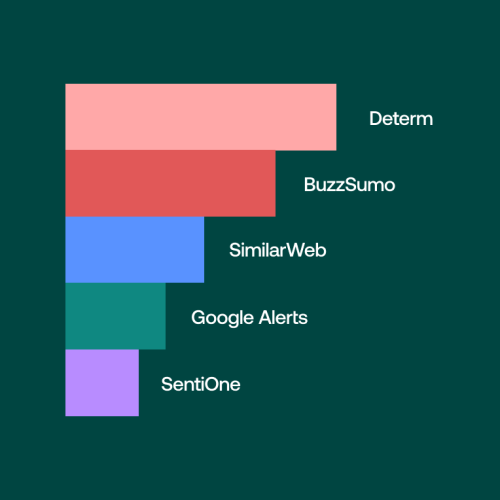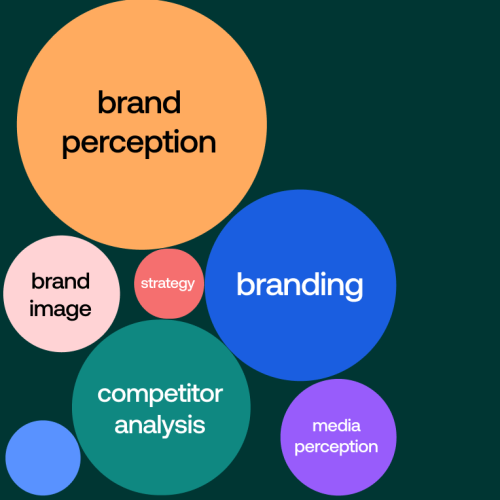Your business is booming. All the effort and hard work are paying off. You have a tribe, a group of loyal followers, and buyers.
The effort you made to grow the brand was successful. The brand and the business are held in high regard and have excellent social media outreach.
? Read Brand Reputation 101: Monitoring, Analysis, and Management Tools
In a world where nine out of ten startups die in the first year, you have emerged victorious.
Now comes the next bit: How to measure your brand reputation.
What is Brand Reputation Measurement?
Brand reputation is the overall perception that consumers have about a brand, based on their experiences with the brand and its products or services, as well as the marketing and advertising efforts.
In Brand Finance’s Global 500 2023 list, Amazon took the top spot, though its value fell from $350 billion to $299 billion. Apple slipped to the second spot, followed by Google, Microsoft, Walmart, and Samsung.

A strong brand reputation can be a competitive advantage for a brand because it helps build trust and credibility with customers and increases the customer base.
Read Reputation Management: 10 Best Practices
Brand Recognition — How Does It Differ?
Do not confuse brand recognition and brand reputation.
Brand recognition comprises visual input, such as logo design, design, color scheme, etc. For better brand recognition you need to employ a branding design agency.
Using online proofing software with the design agency you hire can ensure you always have effective communication in providing feedback on their design work.
The obvious examples include the golden arches of McDonald’s, the Nike swoosh, and the pink and orange logo of Dunkin Donuts.
While a brand can have excellent recognition, it can have a low brand reputation.
Kmart, RadioShack, Nokia, Toys R Us, Compaq, Pan American—the history of marketing and brand management software is replete with brands that were once worth billions and well recognized but have zero value.
Here are 5 differences between the terms.
Marketing Specialist Lito James says “Brand value and brand recognition are both crucial for building a successful brand. While brand value is a quantitative measure, brand recognition is a qualitative measure that can impact customer behavior and drive revenue.”
How to Measure Your Online Brand Reputation?
By its very nature, a brand is an intangible asset. How do you measure something that cannot be felt by the five senses or get quantified through a formula?
We can measure brand reputation indirectly.
1. Stock Valuation
Three types of valuation of a business are possible:
- Stock valuation
- VC valuation
- Value perception
There is no better indicator than stock value. The market always knows best. Facebook shares took a tumble following the Cambridge Analytica scandal. Facebook paid a minor fine and the parent company Meta paid a hefty amount to settle privacy lawsuits. The shares of the social media behemoth dropped as low as $132 during the scandal.
Note that stock price can be measured only in the case of brands that are traded.

What if shares are not traded?
In that case, do you perceive (or an independent consultant perceives) your business is more valuable now than when you began?
If yes, then the brand reputation has soared.
2. Net Promoter Score
Do you ever get pop-ups asking how likely you are to recommend the service to a friend?
Net Promoter Score (NPS) is a popular way to measure customer loyalty. The metric measures the likelihood of customers recommending a brand to others.

To measure NPS, a business typically asks customers to answer the following question on a scale of 0 to 10:
“How likely are you to recommend our product or service to a friend or colleague?”
- Scores 9-10 are considered promoters. (P)
- Scores 7-8 are considered satisfied but susceptible to poaching from rival brands.
- Scores < 7 are considered detractors. (D)
NPS = P- D and can range from -100 (everyone is a detractor) to +100 (everyone is a promoter).
3. Online Customer Reviews
This variation of NPS happens online, in full view of the customers. Online reviews are excellent social proof and offer real-time feedback.
A business rarely has any direct involvement with online business reviews.

The best ones are:
- Yelp
- Trustpilot
A review site not only allows a score (usually 0-5) but also allows reviewers to state exactly what they felt was lacking.
Such as, a restaurant might get reviews stating that the food was excellent but the service was shoddy.
This offers ample scope to rectify the mistake. A moving average of six months is an excellent way to measure brand reputation.
Above all, online reviews are transparent, and many (like Google review) allows the brand ample scope to apologize to the customer and make amends thereafter.
Here’s a method you could use, to compare different brands, on brand value, based purely on their online reviews on Google, Yelp, TrustPilot, Glassdoor, and Amazon. .
The Method
1. Calculate average star rating (from 1 to 5)
Formula:
Average star rating = (Total sum of star ratings) / (Total number of reviews)
2. Allocate weights to each platform based on its importance and relevance to the brand (for example, Yelp is more relevant for restaurants and retail businesses)
3. Obtain a total weighted rating for each brand, using the following formula:
Total weighted rating = (Weight of platform 1 x Average rating on platform 1) + (Weight of platform 2 x Average rating on platform 2) + … + (Weight of platform n x Average rating on platform n)
4. Normalize the total weighted ratings to a common scale (e.g. 0 to 100) to facilitate comparison across brands.
- First, calculate the range of total weighted ratings across all brands (i.e. the difference between the highest and lowest total weighted ratings).
- Then, for each brand, calculate its normalized rating using the following formula:
Normalized rating = (Total weighted rating – Lowest total weighted rating) / Range of total weighted ratings * 100
An example comparison of 3 imaginary brands:
- Johnny’s Gym: Theme-based fitness studio chain for young males
- Sarah’s Organic Cafe: Farm-to-table cafe specializing in healthy and sustainable food
- Dave’s Electronics: Chain of electronics stores offering a wide range of tech products and services
Now, with some basic assumptions, we might arrive at the following score for Johnny’s Gym Jungle

Try to calculate the Normalized rating for the other two businesses based on your assumptions and watch this method come to life.
4. Sentiment Analysis
Not everyone expresses their views through Yelp or Trustpilot.
Also, review sites offer one vote per person.
In our example of restaurant review (above), you get a single vote, regardless if it was a lunch meeting for two or a birthday bash for 14.
Sentiment analysis, also known as opinion mining, goes one step further. It uses natural language processing and machine learning techniques to sift through social media posts, customer reviews, and news articles.
You don’t need complicated processes for these. A simple social monitoring SaaS tool works best. Try Determ. It’s designed to make social listening run on autopilot for startups and lean teams.
The data is cleaned of irrelevant information and then machine learning algorithms, such as logistic regression analyze and interpret the sentiment.
There is always a question of accuracy which depends on the quality of the data and the natural language processing techniques used.
5. Customer Lifetime Value
Customer Lifetime Value (CLV) is a measure of the total amount of sales that a customer is expected to generate for a business. It is a favorite metric of branding agencies.
I have been fond of Nike shoes since I was in school. Till date, I have purchased at least 30 pairs and will probably buy another 50 more in my lifetime.
If I pay $110 per pair (nominal price and exchange rates change over time), my CLV stands at 110 * 80 or about $9000-10000.

Marketers prefer that as Customer Lifetime Value = Customer Value X Average Customer Lifespan and use a far more complex formula than I did to arrive at each value.
Wrapping Up
Before measuring your brand reputation, you must know what you hope to achieve with the data you collect.
Brand reputation measurement can be used to improve customer satisfaction, identify areas for improvement, or understand the impact of marketing efforts. Sharing data with branding services can help your business soar.
Overall, brand reputation measurement is a critical component of any successful IT consulting firms business strategy.
By regularly measuring and analyzing your brand reputation, it is easy to identify areas for improvement.
A reputable branding agency will ensure that your brand is perceived positively by your target audience.






